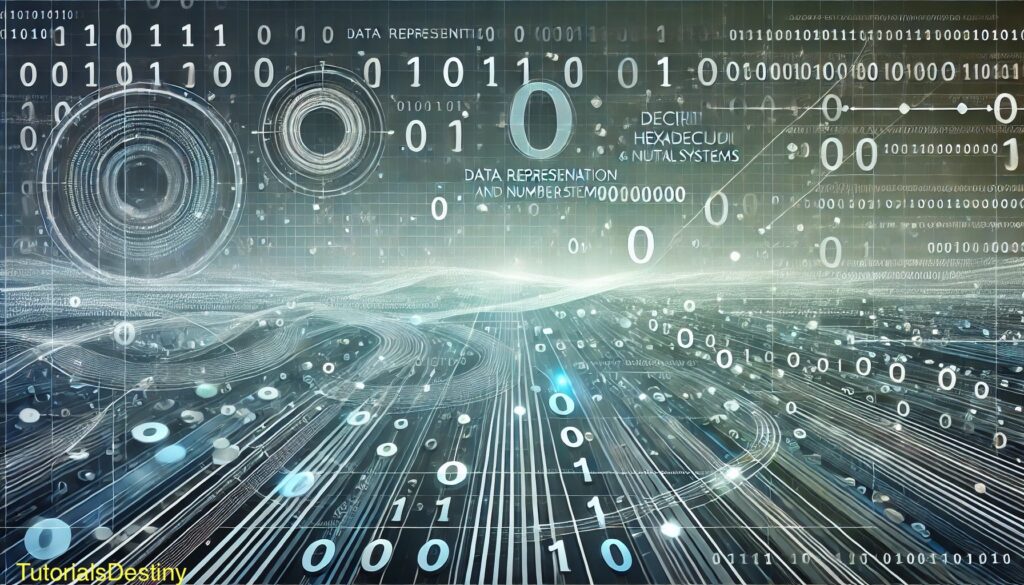Introduction

Data representation and number systems form the foundation of how computers process and store information. Computers use different numbering systems to represent data in various forms, such as text, images, and numbers. Understanding these systems is essential for anyone learning computer science.
What is Data Representation?
Data representation refers to the methods used to represent information in computers. Since computers are based on digital circuits that can only have two states (on and off), they use the binary number system to represent all types of data. Data, such as numbers, characters, images, and audio, are converted into binary sequences of 0s and 1s for processing.
Number Systems Overview
There are several number systems used in computing, each with different bases:
- Binary (Base 2): Uses only two digits, 0 and 1.
- Decimal (Base 10): The standard system used in everyday life, with digits ranging from 0 to 9.
- Octal (Base 8): Uses digits from 0 to 7.
- Hexadecimal (Base 16): Uses digits 0-9 and letters A-F, where A = 10 and F = 15.
Binary Number System (Base 2)
The binary number system is the backbone of computer data representation. Computers store and process all information in binary form. Each binary digit (bit) can be either 0 or 1. Multiple bits are grouped to represent larger amounts of data.
Bits and Bytes: A single binary digit is called a bit, and a group of 8 bits is called a byte.
Example: The binary number 1101 represents the decimal number 13.
- Converting Binary to Decimal
- To convert binary numbers to decimal, multiply each bit by 2 raised to the power of its position and sum the results.
- For example, the binary number 1101 is:
- Converting Decimal to Binary
- To convert decimal to binary, divide the decimal number by 2 and record the remainder. Repeat this until the quotient is 0, and then reverse the remainders.
Decimal Number System (Base 10)
The decimal system is the standard numbering system used in everyday arithmetic. It consists of 10 digits, from 0 to 9. Each digit’s place value is a power of 10.
Example: In the number 254:
Hexadecimal Number System (Base 16)
The hexadecimal system is often used in computing because it is more compact than binary and easier to read for humans. It uses 16 symbols: 0-9 for the decimal values 0-9 and A-F for the values 10-15.
Example: The hexadecimal number 1A3 is equivalent to the decimal number:
- Converting Hexadecimal to Binary
- Each hexadecimal digit represents four binary digits (bits). For example:
- Converting Binary to Hexadecimal
- Group the binary digits in sets of four, starting from the right, and convert each group to its hexadecimal equivalent.
Octal Number System (Base 8)
The octal system is less common today but was historically used in computing. It uses digits from 0 to 7.
Example: The octal number 145 is equivalent to the decimal number:
- Converting Octal to Binary
- Each octal digit represents three binary digits. For example:
Why Use Different Number Systems?
- Binary: Directly corresponds to the on/off states of digital circuits, making it the core system for computers.
- Hexadecimal: Provides a more human-friendly way to represent large binary numbers. For example, 11011011 in binary is DB in hexadecimal.
- Octal: Historically used in some computer systems for compact binary representation.
Floating Point Representation
For representing real numbers (numbers with decimal points), computers use a system known as floating point representation. This allows them to handle a much wider range of values, including very large and very small numbers.
Conclusion
Understanding how computers represent and process data is critical for anyone learning computer science. The use of different number systems, such as binary and hexadecimal, allows computers to efficiently perform complex calculations and store vast amounts of information. By mastering these concepts, you’ll gain a deeper understanding of how computers operate at a fundamental level.
For more tutorials on this topic, visit TutorialsDestiny.